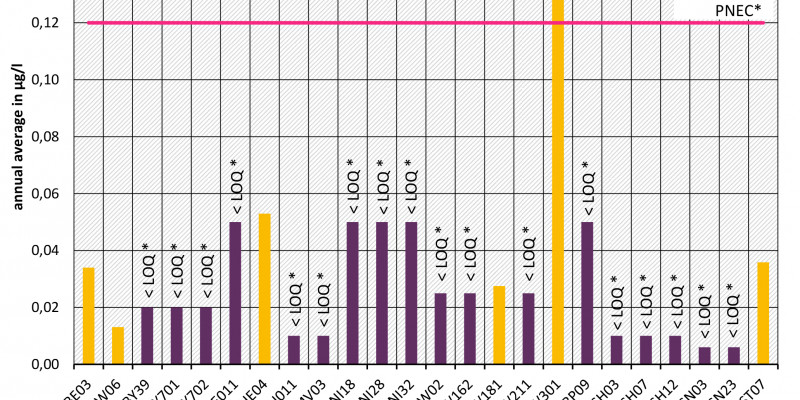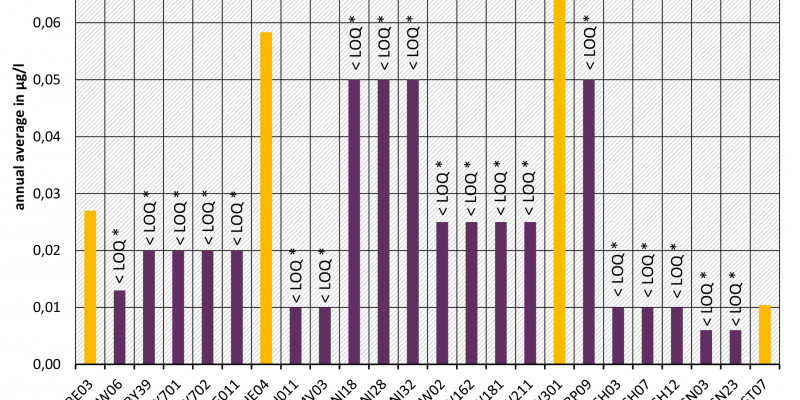Table of Contents
The active pharmaceutical ingredients (API) can also accumulate in rivers in concentrations that are harmful to aquatic biotic communities.
API enter surface waters from the discharges of sewage treatment plants or through their use in livestock production. Therefore the German federal states and the Federal Institute of Hydrology have been measuring select active pharmaceutical ingredients in surface waters for a number of years.
Currently no environmental quality standards have been determined for API either at European or national level. However, monitoring programmes have been initiated at both levels which include measurements of API. A summary of all results 2016 - 2018 in Germany can be found at the end of this article.
European Watch List and national watch list
An EU-wide monitoring programme is the European Watch List. The analgesic Diclofenac, the three hormones estrone (E1), 17-Beta-estradiol (E2) and 17-Alpha-ethinylestradiol (EE2), and the three macrolide antibiotics azithromycin, clarithromycin and erythromycin were included in the first EU Watch List (EU COM 2015/495). In 2016 the German federal states measured these substances at 24 monitoring sites. The EU Commission published the “Review of the 1st Watch List under the Water Framework Directive and recommendations for the 2nd Watch List” in 2018. There are comparisons of measurement results across Europe with PNEC (predicted no-effect concentration). The Review also proposes new standards for a number of API.
The substances included in the national monitoring programme are prescribed in the national watch list, which includes API such as the antiepileptic drug carbamazepine, the antibiotics ciprofloxacin and sulfamethoxazole, and ibuprofen, the most popular painkiller in Germany. Measurements were taken at 48 monitoring stations in 2017.

Source: Umweltbundesamt monitoring_sites_eu_watch_list.pdf
Endocrine active substances
Synthetic hormones such as 17-Alpha-ethinylestradiol (EE2), an active ingredient in contraceptive pills, but also the natural or nature-identical hormone 17-Beta-estradiol (E2) are used specifically to regulate hormonal activity in humans. Both substances and their common degradation product estrone (E1) can therefore also be traced in the environment. They are known to lastingly impair reproduction in fish, starting in very low ng/l concentration. Since the structure of the hormonal system in all vertebrates is very similar, fish are also very sensitive to exposure to hormones and endocrine-active substances. In addition, unlike in birds and mammals, genetic sex determination in fish is much less pronounced. This explains why the contraceptive pill also affects the sex ratio in fish.
In the first EU Watch List (EU COM 2015/495) the analytical method was given and limits of detection set at 0.4 ng/l for estrone (E1) and 17-Beta-estradiol (E2); 0.035 ng/l for 17-Alpha-ethinylestradiol (EE2). The analytical method for 17-Alpha-ethinylestradiol (EE2) was insufficient at three of the 24 monitoring stations to comply with the limits of detection. The EU Commission's PNEC for estrone (E1) was 3.6 ng/l; 0.4 ng/l for 17-Beta-estradiol (E2); and 0.035 ng/l for 17-Alpha-ethinylestradiol (EE2). The diagrams below show the annual mean values of 2016 measurements. PNEC was exceeded at all the monitoring stations where the annual mean value for 17-Alpha-ethinylestradiol (EE2) was above the limit of quantification. The PNEC for estrone (E1) and 17-Beta-estradiol (E2) were exceeded at the mouth of the river Emscher (NW03).
Macrolide antibiotics
The macrolide antibiotics have a complex molecular structure. Azithromycin and clarithromycin are used exclusively in human medicinal products. Erythromycin is used in low amounts in veterinary medicinal products too.
The detection limit in the first EU Watch List (EU COM 2015/495) for macrolide antibiotics was set at 0.09 µg/l. The detection limits for azithromycin at three monitoring stations was higher. The EU Commission report declares a PNEC of 0.019 µg/l for azithromycin, 0.12 for clarithromycin and 0.2 for erythromycin. Mean concentrations of azithromycin and clarithromycin exceeded PNEC at the mouth of the river Emscher (NW03). There was no compliance with the PNEC for azithromycin in the Teltow canal (BE03). The limits of detection for macrolide antibiotics have been lowered in the second EU Watch List (EU COM 2018/840) to 0.019 µg/l.
Diclofenac
Diclofenac is used to fight inflammations and pain. Some 85 tonnes are consumed in Germany every year. It is administered both externally as ointment on the skin and internally (injection, tablet, drops). The first indications of its harmful impact on wildlife were discovered in Pakistan in the early 1990s. At that time mass a nearly extinction of vultures attracted widespread attention. The population of three native vulture species were reduced by 99% as a result of kidney failure, traceable to diclofenac residues which the birds had consumed with the meat of dead cattle. Traces of diclofenac were then also detected in other wildlife including otters and trout.
The limit of detection for diclofenac in the first EU Watch List (EU COM 2015/495) has been 0.01 µg/l. Its PNEC is 0.05 µg/l and is exceeded at 21 of the 24 monitoring stations.

Source: FG II 2.4 / Umweltbundesamt diclofenac_2016_e.pdf
Evaluation at the LAWA measuring sites
The measurements at the LAWA measuring sites show from 2016 to 2018 for the substances in the first EU watch list (EU COM 2015/495):
- The PNEC of the EU Commission for oestrone (E1), for 17-beta-estradiol (E2) and for 17-alpha-ethynyl estradiol (EE2) were exceeded at 1 to 13 of the 63 monitored measuring sites. For 17-alpha-ethynyl estradiol (EE2), the limit of quantification is still not sufficient to check compliance with the PNEC.
- The PNEC was exceeded for 9 out of 95 for azithromycin and 3 out of 138 for clarithromycin. The PNEC for erythromycin was met at all 138 measuring sites. The limit of quantification for azithromycin was also often above the PNEC.
- For Diclofenac, the PNEC was exceeded at around three quarters of the measuring sites.
The substances on the national watchlist complied with the Draft for the annual average environmental quality standard (EQS-Draft) for carbamazepine and sulfamethoxazole at all measuring sites and exceeded it for ciprofloxacin at one measuring site. For ibuprofen, the EQS-Draft could not be checked for compliance at 40 % of the measuring sites because the limit of quantification was higher. Around 50 % of the other measuring sites exceeded the EQS-Draft. These results confirm the measurements at the 48 selected measuring sites at which the national monitoring program was carried out in 2017.









